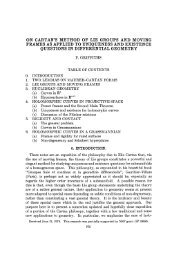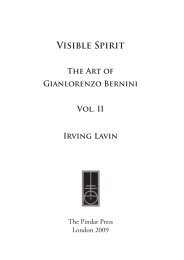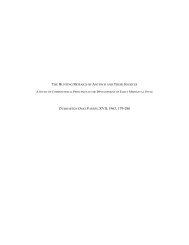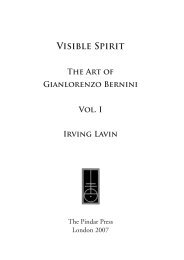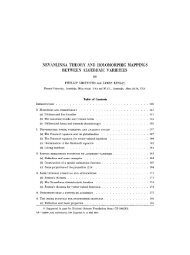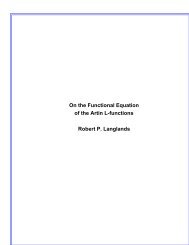View PDF - Project Euclid
View PDF - Project Euclid
View PDF - Project Euclid
Create successful ePaper yourself
Turn your PDF publications into a flip-book with our unique Google optimized e-Paper software.
For k we have (4.33)<br />
CURVATURE AND COMPLEX SINGULARITIES 489<br />
c() (n + 1)0 + c1(O)<br />
which trivially implies (4.34). For k 2, which is the crucial case, we have<br />
from (4.33)<br />
c2()/ to"- c2(O)/ to"- + Cto,, + L(O)to,<br />
where L(O) is linear in the entries of O. From (4.30) we deduce that L(O) is a<br />
linear combination of the expressions<br />
where repeated indices will now be summed. From the theory of unitary invariants<br />
(cf. the reference in footnote ) of 4) we infer that L(O) is a linear<br />
combination of the two expressions<br />
B the smmetr k k these are both equal, and since<br />
2 0 2<br />
. k<br />
L(O)" Cc(O) A "-<br />
(kvokOov A 0o).<br />
This establishes (4.34) for k 2, and the general argument is similar. We note<br />
again the essential role played by the symmetry of the second fundamental<br />
form.<br />
We also remark that, by the discussion in 3(c), the formula (4.32) extends to<br />
the case where c N- may have singularities; the point is that both sides<br />
are defined as the corresponding integrals over smooth points and these integrals<br />
are absolutely convergent.<br />
(iii) Now let M C N {0} be a complex manifold with residual image in<br />
N- 1. Over M we consider the usual Darboux frames {z, e, ., eN}, and over<br />
we have the frames {Z0,’’ ", ZN-} () where Z0 ez/ z]]. Over<br />
smooth points of we have z A e A A e, 0 and the two sets of vectors<br />
{z, e, ., e,} and {Z0, ", Z,} both span the fibre of the bundle F at Z. The<br />
pair of exact sequences<br />
(4.35)<br />
0H*F T()H*0<br />
O T(M) F Q O<br />
contains the relationship between the bundles T(M) and T(), both of which<br />
are complex-analytically isomorphic to the holomorphic tangent bundle of M<br />
but which have quite different metrics. By (4.32) we have averaging formulas<br />
for the Chern forms c(O) of F, and we want to use these to deduce averaging<br />
formulas for the Chern forms c() of T(.





